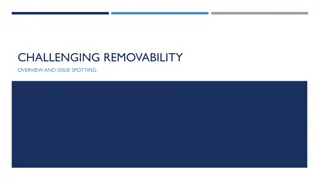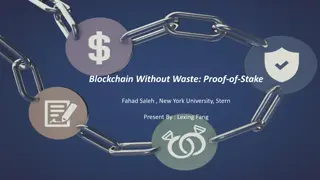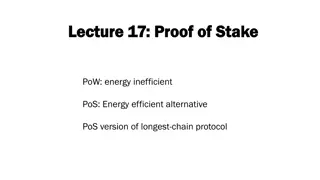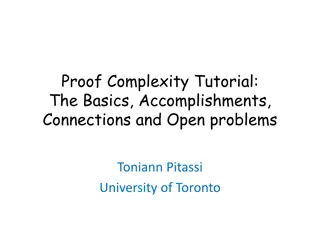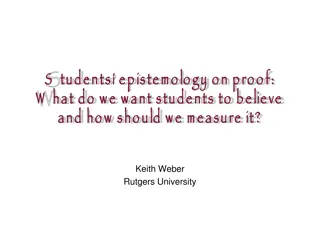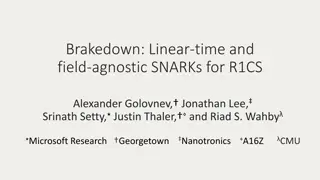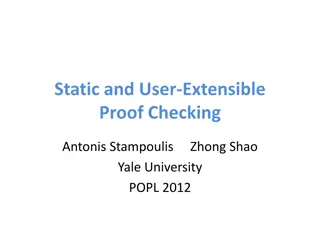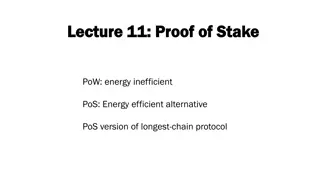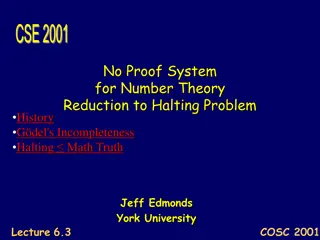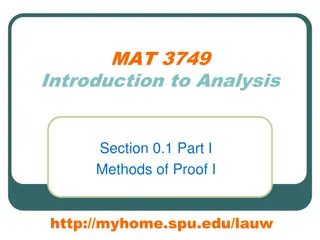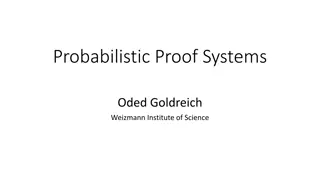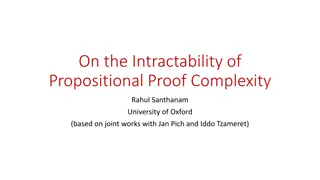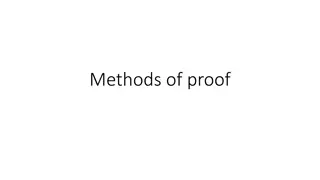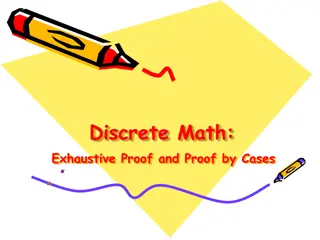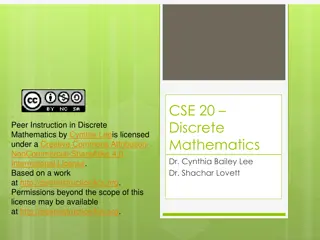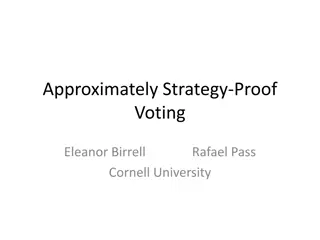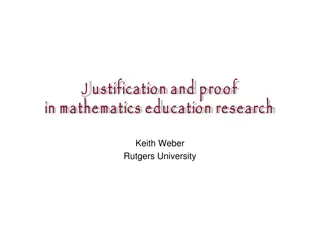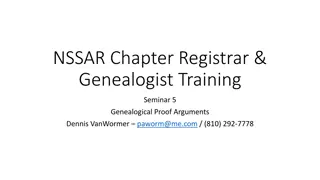Efficient Interactive Proof Systems Overview
This document discusses various aspects of efficient interactive proof systems, including doubly efficient IPs, simple doubly efficient IPs, and the Sum-Check Protocol. It explains concepts such as completeness, soundness, and strategies for verifiers and provers. The content covers examples like NP-witness verification and t-Clique scenarios, illustrating the effectiveness of interactive proof systems in computational complexity theory.
- Interactive Proof Systems
- Computation Complexity
- Verification Strategies
- Sum-Check Protocol
- Cryptography
Download Presentation

Please find below an Image/Link to download the presentation.
The content on the website is provided AS IS for your information and personal use only. It may not be sold, licensed, or shared on other websites without obtaining consent from the author. Download presentation by click this link. If you encounter any issues during the download, it is possible that the publisher has removed the file from their server.
E N D
Presentation Transcript
On Doubly On Doubly- -Efficient Interactive Proof Systems Interactive Proof Systems Efficient Oded Goldreich Weizmann Institute of Science
Interactive Proof Systems Interactive Proof Systems [GMR] [GMR] Prover Verifier I love you (and you love me too) What would we do, as friends? Have fun. Fun - sounds like a buddy movie. Yes, exactly. Like Thelma and Louise. But... without the guns. Oh, well, no guns, I don't know... Petra Camille (not Venus) When Night is falling (Canada, 1995).
Interactive Proof Systems Interactive Proof Systems [GMR] Prover THM [LFKN,S]: IP = PSPACE Verifier X (common input) Computationally unbounded PPT Completeness: If X is in the set, then the verifier always accepts (under a suitable prover strategy) Soundness: If X is not in the set, then the verifier rejects w.p. at least , no matter what strategy the (cheating) prover employs. THM [LFKN,S]: Every set in PSPACE has an interactive proof system.
Doubly Doubly- -Efficient Interactive Proof Systems Efficient Interactive Proof Systems [GKR] [GKR] Prover Verifier X (common input) Prescribed prover is PPT Almost linear time (or just o(deciding)). Completeness: If X is in the set and the prover follows the prescribed strategy, then the verifier always accepts . Soundness: If X is not in the set, then the verifier reject w.p. at least , no matter what strategy the (cheating) prover employs. N.B.: As before; that is, soundness hold wrt computationally unbounded cheaters!
Simple doubly-Efficient Interactive Proof Systems Ex 1: In some cases, (almost linear-time verifiable) NP-witnesses can be found in polynomial-time (e.g., perfect matching, primality, t-Clique for constant t>2). Ex 2 [GR17]: no-t-Clique for constant t>2. EQ Is a poly of indiv-deg. t2 |F| > 2ll Apply the sum- check protocol. Verify the residual.
T The Sum he Sum- -Check Protocol Check Protocol [LFKN] [LFKN] m-variate polynomial of individual degree |H|-1 univariate polynomial of degree |H|-1 Evaluate the polynomial at a single point.
Simple doubly Simple doubly- -Efficient IPs for Local. Char. Sets Efficient IPs for Local. Char. Sets [GR17] [GR17] In case of no-t-Clique, n(i1, ,it) = j,k xi_j,i_k View n(w)i [n] as a (log n)-long binary sequence. Consider the (log n) corresp. low-deg polys over F. Proof Idea: For a finite field F,consider low degree ``extensions of the Boolean formulas. EQ is the equality polynomial of the penultimate slide. All polys have small Arithmetic formulas. Apply the Sum Check to the sum over w.
D Doubly oubly- -Efficient IPs for log Efficient IPs for log- -space uniform NC THM: Every set in log-space uniform NC has a doubly efficient interactive proof system. For depth d(n), we get d(n) poly(log n) rounds. space uniform NC [GKR] [GKR] Can easily verify the first and last conditions. Verify at random point by using the Sum-Check Protocol. Problems: After the Sum-Check we need to 1. evaluate i in almost linear time. 2. evaluate i on two points. k = |H|m with |H|=log n
D Doubly oubly- -Efficient (constant Efficient (constant- -round) IPs for round) IPs for S SC C [RRR] [RRR] THM: Every set in SC has a doubly efficient interactive proof system with constant number of rounds. Ditto for TimeSpace(poly,n0.5). One of the proof ideas: Batch verification; that is, verifying t claims at cost of o(t) verifications. Used to reduce the verification of the existence of a L-long path to the existence of t paths, each of length=L/t. A sanity check: Possible if you don t care of prover time (via IP=PSPACE). Warm-up: Batch verification for UP (i.e., NP with unique witnesses). Single instance p(n) v(n) t=t(n) instances t(n) p(n) t(n)1/O(1) v(n) + t(n) t(n)1/O(1) c(n) + t(n) Prover time Verification time Communication c(n)
Batch verification for UP Batch verification for UP [RRR] For d = t(n)1/2and d = d log n, consider the parity check F: 0,1 t(n) for each v, each Hamming ball of radius d contains at most one pre-image of v under F. [RRR] 0,1 d such that *) input-oblivious queries, recognizable canonical proofs.
Wider Perspective: the source of proofs Wider Perspective: the source of proofs Proofs do not fall out of thin air. Setting 1: The prover s on-line work (de-IP, reviewed here). Setting 2: Provided by the (high-level) application/user + PPT. E.g., NP-witness provided to a prover in a zero-knowledge system. Setting 3: Constructed in PPT with oracle access to deciding. Different notions of relatively efficient provers. They deserve further study. A Taxonomy of Proof Systems (1995).
END Related papers available at http://www.wisdom.weizmann.ac.il/~oded/de-ip.html



